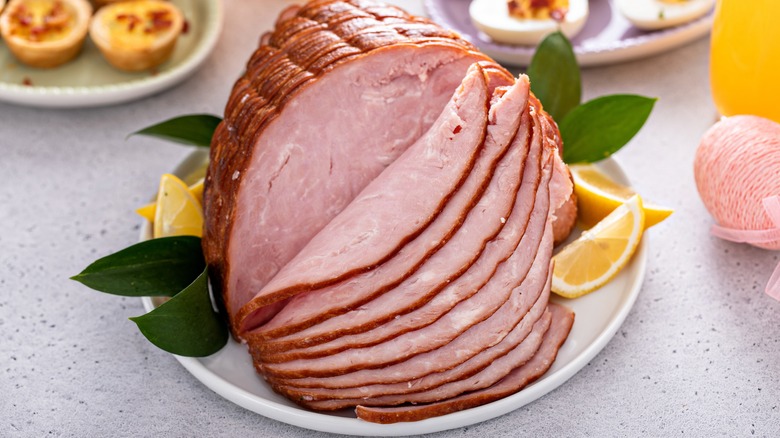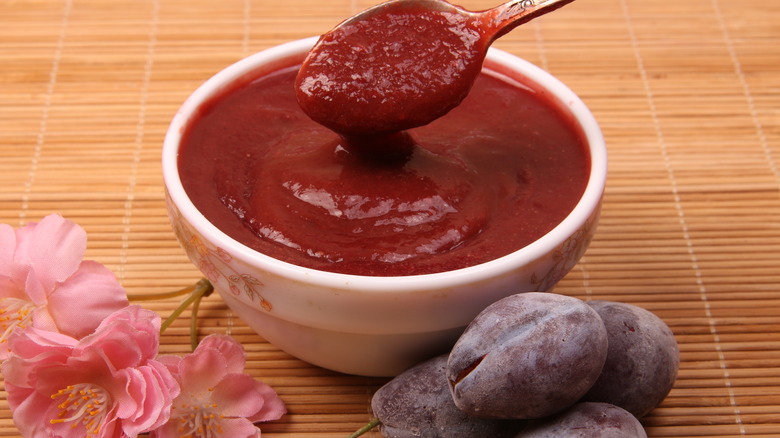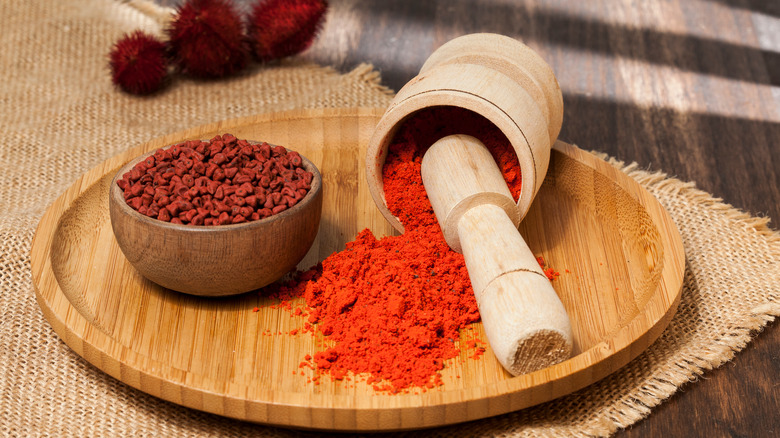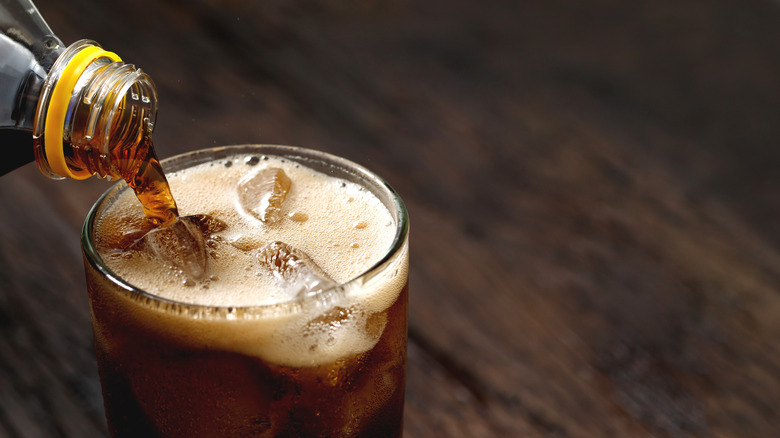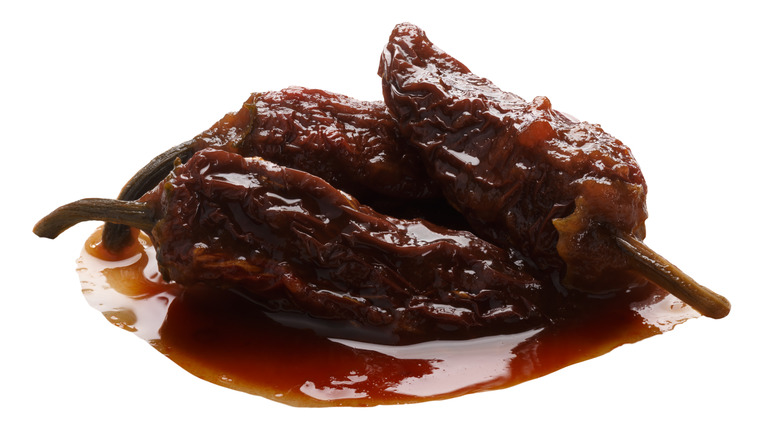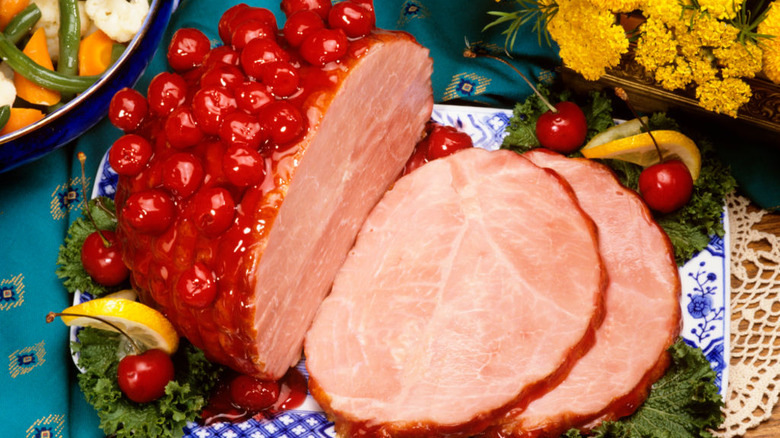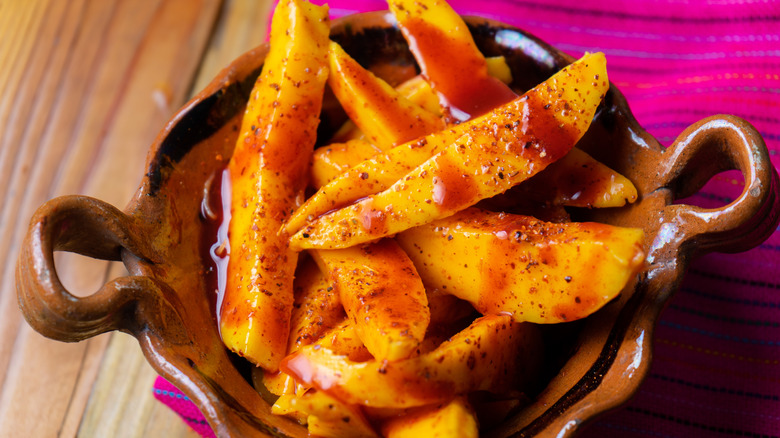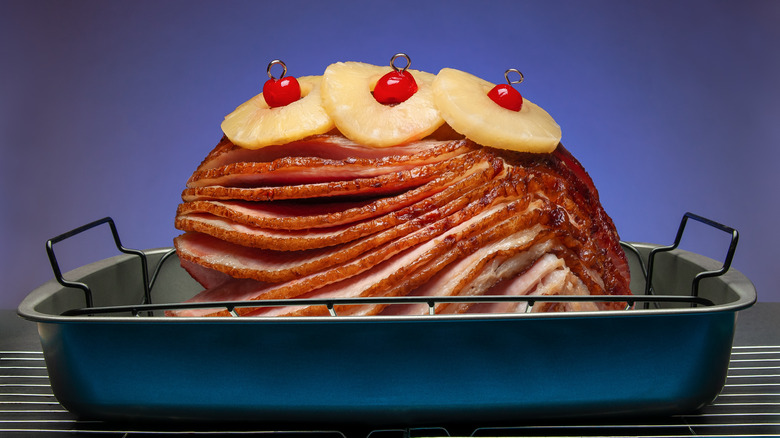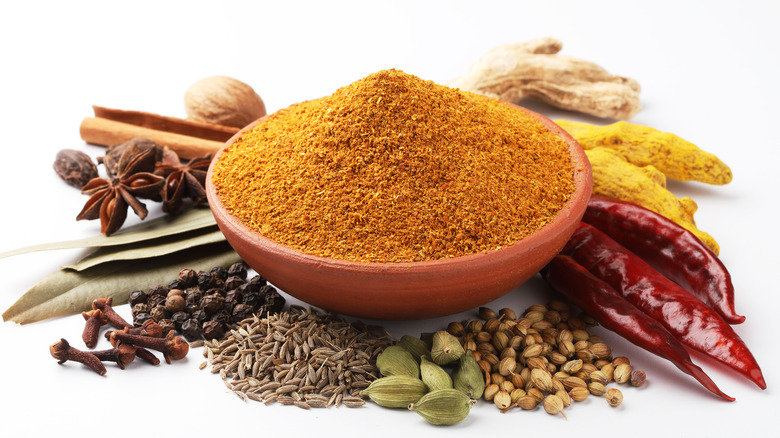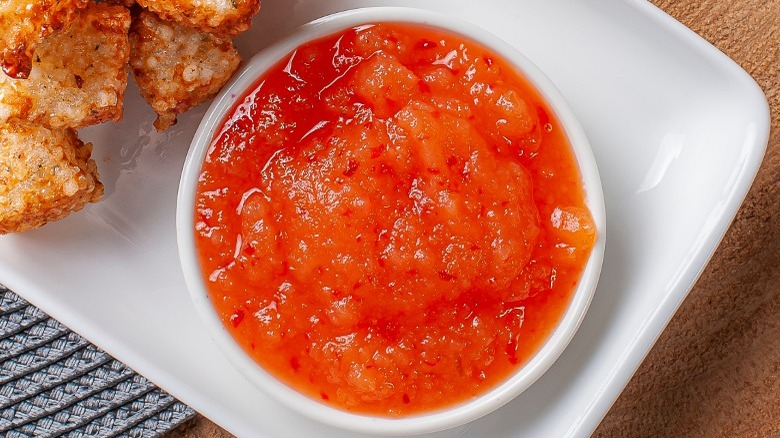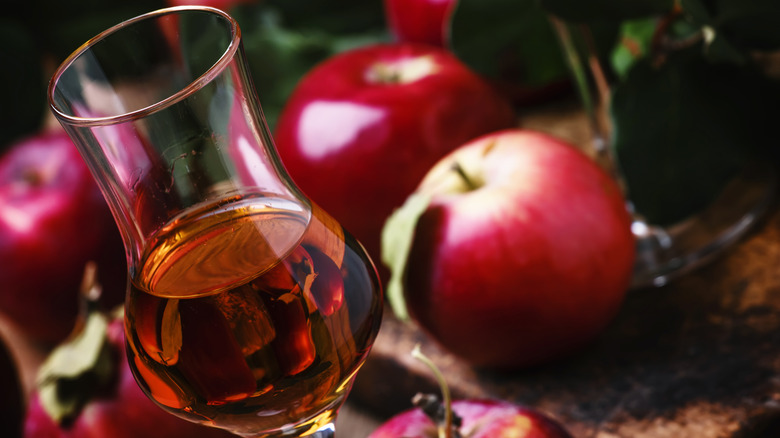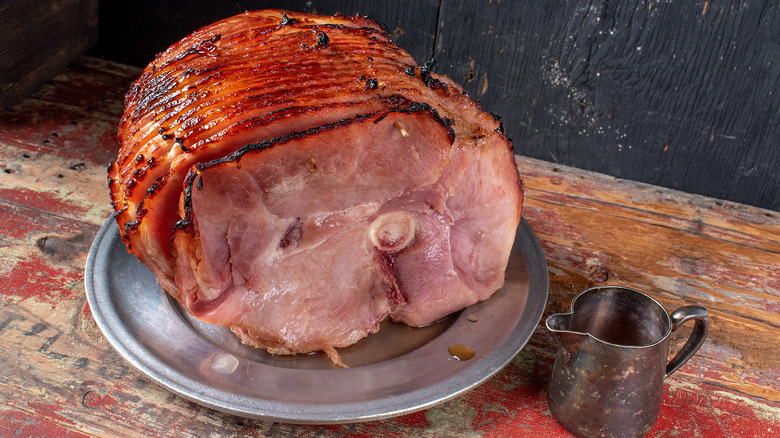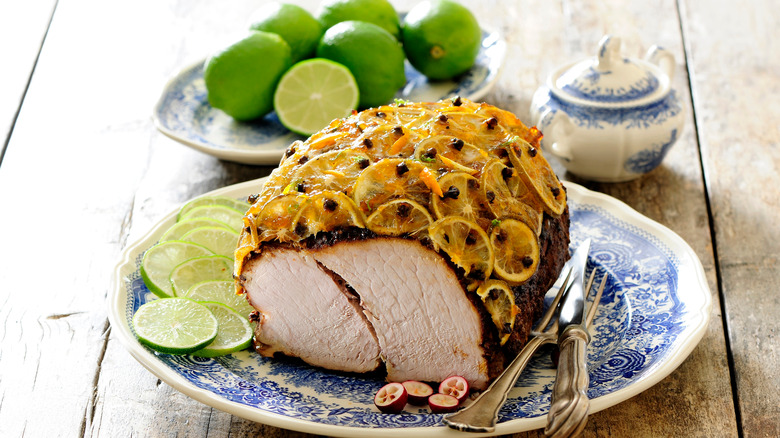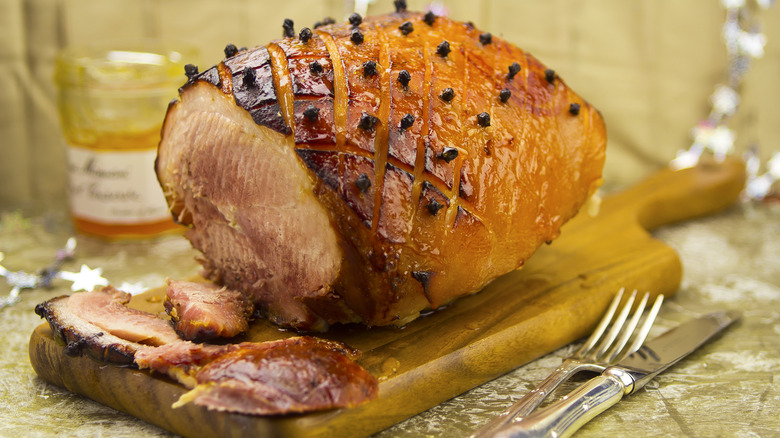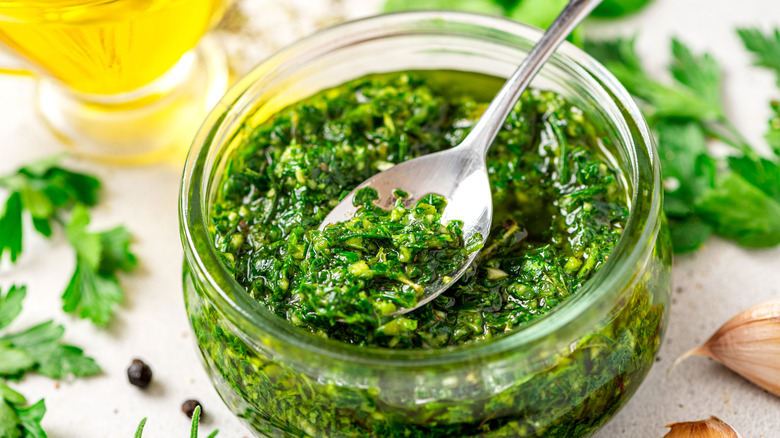The Ingredients You Need To Elevate Your Baked Ham
Baked ham is a simple and elegant dinner that always hits the mark. Although the classic dish may be intimidating at first, it's a great way to show off your cooking chops and impress your guests. The first step is choosing the right ham. The photogenic pink ham commonly seen on holiday dinner tables is usually wet-cured, meaning it's been brined in a solution of saltwater and other ingredients, and may come pre-cooked. It is sold bone-in or boneless. Most agree that there isn't a huge difference in taste or texture between the two, but if you want to make the most of your purchase, a bone-in ham has the extra benefit of the bone, which can be used for soup or stock. Many supermarket hams are pre-cut spiral hams. These make the slicing and serving easy but tend to dry out easily, while a whole uncut ham stays juicier.
Once you've chosen your ham, it's time to season it, and there are many great ways to season baked ham. The classic way is with brown sugar and spices, but if you want to try something different and elevate your baked ham with new flavor combinations, we have several tasty ideas to make your holiday ham even better.
Plum sauce
Chinese plum sauce is common in duck and pork dishes, and it's perfect for baked ham. Plum sauce has a tart taste with sweet undertones that complement the salty meat. You can buy it at most supermarkets and international stores. Plum sauce, like most sauces, varies from brand to brand, so it helps to do a little research and consider the flavor profile before buying. Plum sauce can lean sweeter or a little more tart; if you get one that is a little too sweet, you can cut the sweetness with a little soy sauce or Dijon, and if it is a little too tart, you can add a bit of honey to get to the level of sweetness you prefer.
The best time to add a plum sauce glaze is toward the end of your baking time. Remove the ham from the oven and spread the glaze on the meat, and then cover it with foil and finish baking, or heating if you're using a pre-cooked ham.
You can also make homemade plum sauce, but keep in mind that you will need the right kind of plums. Fresh friar plums are the best for sauce and are also available in a paste.
Tequila and achiote
If you want to do something a little different with your baked ham this year, try a tequila and achiote glaze. This combination of flavors is inspired by Mexican cuisine and is ideal for baked ham but can be used on chicken, too. Achiote is a red paste sold in international supermarkets or the international section of your local market. The bright red powder is made from annatto seeds, a staple spice in Latin American and Caribbean cuisine. These small red seeds are ground into a fine powder and added to meat rubs, rice, soups, or anything that needs flavor. The tequila adds a unique taste and works as a transportation system for the achiote, helping it stick to the ham. This glaze is especially good for smoking and grilling a pre-cooked ham.
When choosing tequila to cook with, you don't have to shell out big bucks for top-shelf añejo; an inexpensive white or silver tequila is fine. Save your high-end stuff for sipping while the ham is cooking. The alcohol will cook off in the oven, making it safe for anyone who is avoiding alcohol. While the tequila adds flavor, it doesn't lead to an overpowering taste that might be off-putting.
Coca-Cola
Coca-Cola is for more than just quenching thirst on a warm day; it actually has some other uses in the kitchen, like in a marinade or glaze for savory cuts of baked ham. The flavor profile of the iconic soda is a mix of vanilla, cinnamon, and citrus — all great flavors for sprucing up a chunk of meat. The sugar in the soda will caramelize the outside of the Coca-Cola ham, but if you prefer it a little less sweet, add a bit of apple cider vinegar to help cut the sweetness. A teaspoon or two of mustard is another option. Also, a splash of soy sauce can tamper the sweetness with some umami flavor.
Another option is to use Dr. Pepper. While Coke and Dr. Pepper have a significant difference in taste if you are drinking them, that difference isn't glaring when used in a glaze or marinade.
Chipotles and orange juice
Chipotle chilies are jalapeños that have been dried and smoked. They are hotter than fresh jalapeños and are usually sold canned in a deep red adobo sauce. Chipotles in adobo pureed with orange juice can add a nice kick to a glaze for baked ham, and the citrus creates a balance between sweet and spicy. Freshly squeezed orange juice isn't the best choice for a glaze because it isn't as sweet as the store-bought premade juice. That sugar content is needed to cut through the smoky chipotle chilies. But that doesn't mean you can't use fresh oranges because the glaze can benefit from some orange zest to balance sweet and spicy.
Look for chipotle chiles in adobo in the international section of the supermarket. One small can should be enough to get the right flavor without being too hot. But, if you are a heat-seeking home chef, then you might want two cans.
Bourbon and cherries
Sweet, slightly tart cherries and the warm caramel taste of bourbon go great together. The two are often paired for the classy dessert cherries jubilee or for a savory barbecue sauce. So it's no surprise these two together make a tasty bourbon and cherry glaze for a baked ham.
While fresh cherries are ideal for bourbon cocktails or cherry bourbon desserts, cherry jam or preserves work better in a glaze because of the added sugar. Bourbon's slightly oaky taste with vanilla undertones keeps the glaze from being too sweet, balancing the two.
While any standard bourbon will work for the glaze, there are a lot of flavored ones available, too. For a sweeter glaze, salted caramel or honey bourbon are good choices, and if you prefer a more fruity finish, peach or blackberry bourbon are excellent complements to the cherries. Meanwhile, a spiced bourbon adds a more complex finish to the glaze.
Chamoy and mango
If you love to combine sweet and spicy, then chamoy should be on your radar. Chamoy is a uniquely Mexican sauce with a mix of flavors and can be sweet, sour, or tangy. It's often paired with fruit candies like mango lollipops and sugar-coated treats. Street vendors drizzle it on fresh fruit like coconut, mango, papaya, and even cucumbers. But it's not just for a sweet treat. It can be used in cocktails and drinks like Mexican micheladas. And it adds something special to a salty chunk of ham.
Chamoy is a medley of flavors that all work together. It is made with dried apricots, chili de arbol, lime, other ingredients, and spices. Sometimes, spicy Tajín seasoning is added, too. The mix hits the taste buds full force, bringing salty, sweet, sour, and tangy all at the same time. You can find chamoy in international markets or online sold in powder or paste. To make a glaze with the powder, you will need to mix it with mango juice. But as a paste, you can mix it with a fresh mango puree and slather it on like a spice rub.
Pineapple
No matter where you fall on the great pineapple-on-pizza debate, there is no denying that ham and pineapple are a delicious combo. Ham is salty and smoky, pineapple is sweet and acidic, and when the two meet, it's a flavor explosion and makes an excellent glaze for baked ham.
Fresh or canned pineapple can be used to make a glaze depending on the level of sweetness desired. Fresh pineapple leans more acidic than canned pineapple, and you may need to add more sugar or honey to sweeten it. Canned pineapple is in a sweet syrup and may even be too sweet. If that's the case, add a splash of soy sauce or Maggi seasoning to balance it. If you like a sweet and heat combination, candied jalapeños pair well with pineapple for a sweet, spicy glaze that stands up to the salty ham. Save a few slices to decorate the pineapple-glazed ham for a nice presentation to impress your guests.
Curry
Curry and baked ham may not seem like a natural pairing, but once you try it, you will be questioning why you hadn't combined the warming aromatic spice with the savory meat before now. Curry mixed with brown sugar elevates a baked ham from basic and boring to a uniquely flavorful dish.
The first step to making a glaze with curry is choosing the right type of curry. There are many different kinds, from mild to spicy, so choosing the right one to satisfy taste without dominating the entire dish takes some basic knowledge. Curry comes in powder or paste, ranging from yellow to green to red. Curry paste is more common in Thai dishes, where it is often mixed with coconut milk, while curry powder is more common in Indian cuisine. Most recipes for curry glaze use powder mixed with a sweetener like honey or syrup, making the curry part of an ensemble of flavors. You could try to use curry paste, but it will be pretty intense in flavor and overpower the taste of the ham, even if you choose milder yellow over spicier red or green.
Pepper jelly and coffee
Salt and pepper, peanut butter and jelly, and sweet and sour are pairings that go together, but pepper jelly and coffee ... not so much. While on paper, this duo seems like an odd couple, in reality, the two are a great match. The sweet, spicy pepper jelly combined with coffee's bold, rich, nutty flavor makes an excellent baked ham glaze.
There are too many types of pepper jelly to describe; some pepper jellies use jalapeños, and others use habaneros or serrano peppers, so the heat range heat varies. Some add fresh fruit for a natural sweetener, like apricot pepper jelly. Choose a pepper jelly with a heat level that will add to the overall dish without overwhelming the final product.
You can find pepper jelly at most supermarkets or even make your own — but don't make the mistake of buying pepper jam. Pepper jelly and jam may seem interchangeable, but pepper jam has pieces of chili and fruit, while pepper jelly does not, making it easier to control the heat and sweet levels. For coffee, choose a dark, full-bodied roast for the best flavor.
Rum and apples
Rum is for more than just fancy cocktails; it makes a great glaze, too, especially when paired with crisp, tart apples. Rum-pineapple glazes are popular, but switching out the sweet pineapple for apples makes this a glaze that stands out from the rest.
There are many different types of rum, but for simplicity, let's look at light and dark rum. Light rum hasn't been aged; it is a little sweet and usually mixed into fruity cocktails. Dark rum is aged, giving it a more complex flavor profile. It is often sipped to appreciate the layered tones. Dark rum is better to cook with, as it adds more than just sweetness to a glaze. But you don't have to break the bank and buy the best rum; just stick to a dark rum that's within your budget.
The best apples to use in a rum-apple glaze are those that lean on the tart side, like Granny Smith or Pink Lady. They will add a slightly sour tone to match the rum's intensity and the pork's saltiness.
Apple cider vinegar and molasses
Making this glaze is easy, and you probably have the ingredients already in your pantry. Apple cider vinegar and molasses work well together in marinades and glazes, and if you are looking for a new flavor to add to your baked ham, then this is it. Apple cider vinegar gives the glaze depth with a slight acidity, while the molasses tames the acid with some sweetness. Plus, apple cider vinegar has the added benefit of tenderizing the meat, making it easy to slice.
Good vinegar is the key here. Reach for unfiltered apple cider vinegar, which will have more flavor. Light or dark molasses are both good choices. Light molasses has a lighter, less rich taste, while darker has a more intense flavor. Pomegranate molasses is another good choice, adding a nice fruity touch to your finished ham. Make sure to avoid blackstrap molasses because it isn't as sweet and can be bitter.
Cloves and citrus
Cloves are the dark little spice that packs a lot of flavor, and they're often poked into baked ham to infuse the meat while it cooks. One way to elevate the clove-ham combo is to pair it with fresh citrus like oranges, mandarins, grapefruit, lemons, or limes. Once the cloves have studded the ham, use the citrus juice as a simple no-fuss glaze. For a sweeter glaze, stick to oranges and mandarins, and for a more complex flavor, try mixing oranges with grapefruit. Mix oranges with tart lime or lemon juice for a slight tang.
Cloves often get lost in the back of the spice cabinet because they aren't used as frequently as other spices like oregano and pepper. Before you start stabbing them into your orange-clove ham, check the label to see how old the cloves are and give them a smell test. While cloves can last up to four years, it all depends on how they are stored. If they aren't stored properly, they can dry out and lose potency.
Apricot preserves and ginger
Are you looking to make a standout holiday dinner with a ham that everyone will be talking about? Then look no further than apricot preserves and ginger. Apricot preserves add the right amount of sweetness, one that's complex enough to stand out from the typical apple and orange glazes. The sticky, sweet preserves paired with tangy ginger create a unique combo to slather on your baked ham.
Ideally, homemade apricot preserves are the best choice. If that isn't an option, store-bought preserves work, too. As for ginger, fresh or powdered will work, but keep in mind that fresh ginger needs to be peeled and finely minced for the best results. Nobody wants to bite into a savory ham and get a mouthful of ginger. Use a small spoon to scrape the peel off before mincing it. You could also just skip this step and use powdered ginger, but if you do, keep in mind that powdered ginger is much stronger than fresh ginger, so don't overdo it.
Herb marinade
A medley of fresh green herbs can give a baked ham a flavorful, bright-tasting makeover. This is the perfect way to season a baked ham when your taste buds are tired of overly sweet dishes. The best way to use herbs on a baked ham is to marinate the ham overnight in a mix of your favorite herbs and white wine. The next day, remove the marinade and bake.
Another way to use fresh herbs to flavor a baked ham is to make a side sauce like an Italian gremolata or Argentinian chimichurri. Classic gremolata is a simple and elegant mix of Italian parsley, garlic, and lemon zest. Be sure to chop the parsley by hand, rather than using a food processor, so it keeps its texture. Chimichurri is usually paired with beef but is also a good condiment for baked ham. It differs from gremolata due to the presence of cilantro and red paper flakes, which give it more of a kick.
